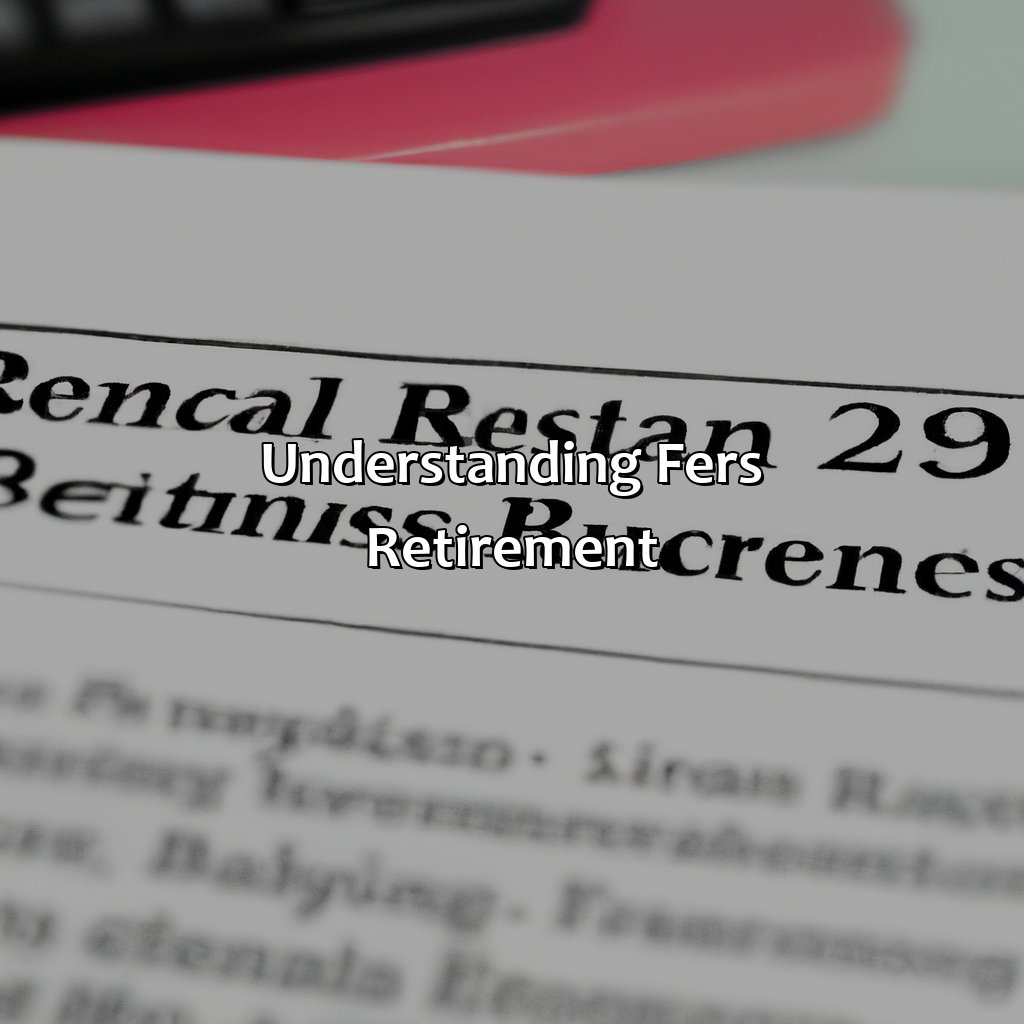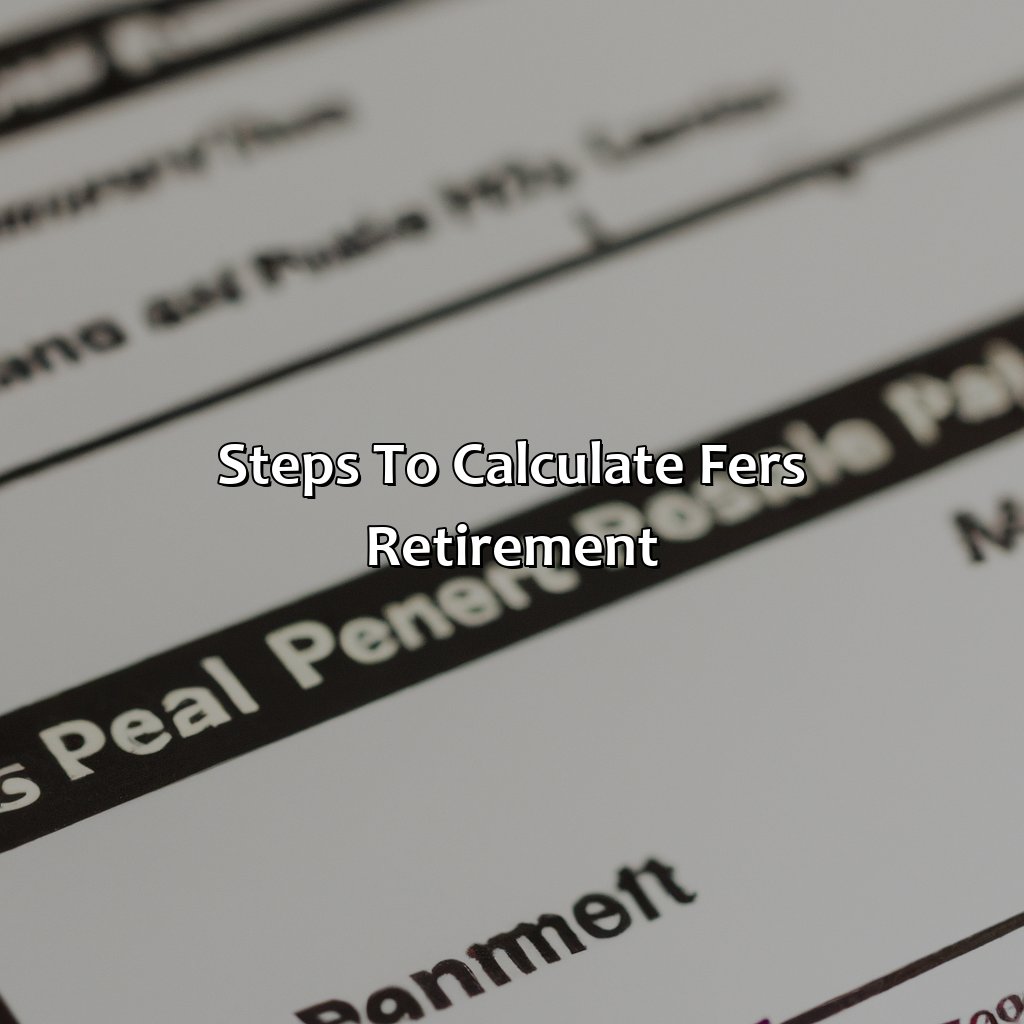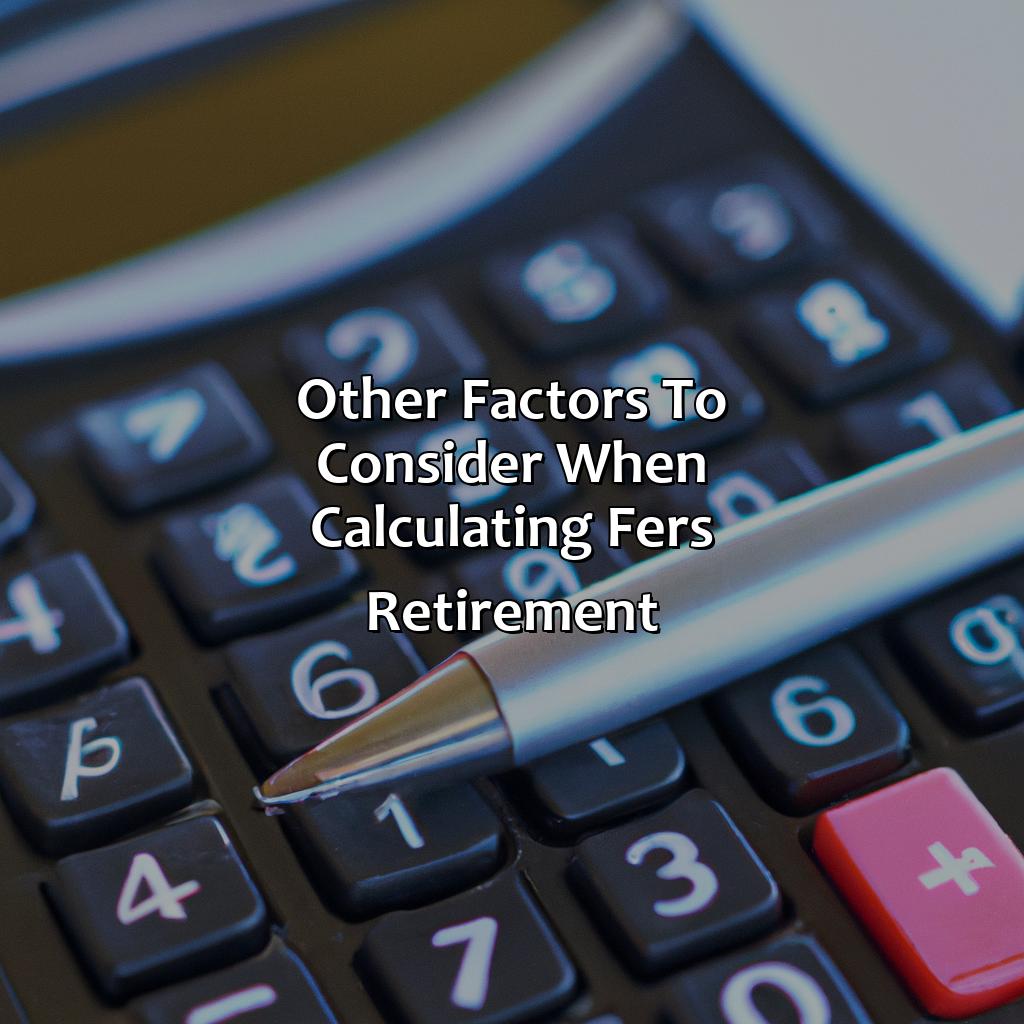How To Calculate Fers Retirement?
Key Takeaway:
- FERS retirement is a retirement plan available to federal employees that includes a pension, Social Security benefits, and a Thrift Savings Plan account. It provides a comprehensive retirement benefit package that is a combination of pension, Social Security, and a savings plan.
- Eligibility requirements for FERS retirement include completing at least five years of creditable civilian service, meeting minimum age requirements, and meeting minimum creditable service requirements.
- Calculating FERS retirement benefits involves determining your high-3 salary average, calculating your years of creditable service, multiplying your high-3 salary by your years of creditable service, factoring in cost of living adjustments, and factoring in special retirement supplements.
Do you want to ensure a secure financial future? Calculating your FERS retirement should be top priority. With this comprehensive guide, you can easily navigate the process and make confident decisions about your retirement.
Understanding FERS Retirement
To comprehend FERS Retirement and its subsections, one must understand the basics of retirement benefits. Start by becoming familiar with FERS retirement specifics, then explore the three subsections that elaborate on the main topic. These subsections include:
- ‘What is FERS Retirement?’
- ‘Eligibility Requirements for FERS Retirement’
- ‘Calculating Your FERS Retirement Benefits’

Image credits: retiregenz.com by Harry Jones
What is FERS Retirement?
Federal Employees Retirement System (FERS) is a government-sponsored retirement system. FERS calculates retirement benefits based on three sources: the employee’s Thrift Savings Plan (TSP), Social Security, and pension.
Calculating FERS retirement involves understanding service credit, high-3 average salary, and age at retirement. Service credit refers to completed years of federal employment. The high-3 average salary entails averaging the salaries of an employee’s highest-paid three years of service. Age at retirement determines if an employee receives an immediate or deferred annuity.
Additionally, depending on the length of service, employees may receive a special retirement supplement until they are eligible for social security benefits. This supplement is calculated based on the amount an employee would have earned in FERS, assuming they were eligible for social security benefits upon retiring.
Pro tip: When calculating FERS retirement, consider consulting with a human resources specialist or financial planner to ensure you are taking all factors into account.
When it comes to FERS retirement eligibility, it’s like trying to qualify for a marathon – only this one lasts for the rest of your life.
Eligibility Requirements for FERS Retirement
To qualify for Federal Employees Retirement System (FERS) retirement, employees must satisfy specific criteria:
- They must have completed at least five years of creditable civilian service and be under the age of 62 at the time of resignation or retirement.
- Federal workers who are aged above 62 with five years of service can also apply for FERS retirement.
- Lastlty, those who reach their Minimum Retirement Age (MRA), which varies depending on birth year and ranges from 55 to 57, with ten years of service can retire too.
In addition to these requirements, there are several other factors that may affect an employee’s eligibility for FERS retirement benefits. For instance, disability retirements apply to those individuals that become incapacitated due to illness or injury and can no longer work in their existing job roles. However, as opposed to voluntary retirements, they require medical certification proving their disability.
It is essential to note that even if you meet the eligibility requirements for FERS retirement benefits, it does not guarantee maximum annuity payout amounts immediately. The amount received depends on multiple factors such as years serviced and high three-average salary calculation principles.
According to NARFE (National Active and Retired Federal Employees Association), federal workers spend an average of 20-30 years in public service before retiring.
Time to break out the calculator and kiss your social life goodbye – we’re diving into the nitty gritty of FERS retirement benefits.
Calculating Your FERS Retirement Benefits
For those seeking information on how to calculate their FERS retirement benefits, understanding the complexities of the Federal Employee Retirement System can be daunting. However, with proper guidance and accurate data, calculating your retirement benefits can become a breeze.
To help with this task, we have created a comprehensive table outlining each component that makes up your FERS retirement calculation. This includes data such as your total years of service (used to determine your pension), your high-3 average salary and the contribution made by both you and your employer towards FERS.
| Component | Data |
|---|---|
| Total Years of Service | XX years |
| High-3 Average Salary | $XX,XXX |
| Contribution by Employee | XX% |
| Contribution by Employer | XX.X% |
| Pension Calculation Formula | 1% x High-3 x Total Years of Service – FRA Percentage |
| Social Security Income Calculation | Bend points applied based on income and age |
| Thrift Savings Plan Contribution | Maximum annual contribution is $19,500; catch-up contributions allowed for those over age 50 |
It’s important to note that certain unique details may also impact your FERS retirement calculation. For example, if you have made any deposits into the retirement system or had any military service time that can be credited towards civilian service time. These factors will require additional calculations and considerations when determining your final retirement benefits.
Overall, understanding how to accurately calculate your FERS retirement benefits can provide peace of mind during an already stressful time. With resources such as our comprehensive table and professional guidance, calculating your FERS retirement benefits should feel manageable.
According to OPM.gov statistics, as of September 2019 there were over 2 million federal employees enrolled in the Federal Employees Retirement System (FERS).
Ready, set, retire! Follow these easy steps to calculate your FERS retirement plan and start planning your golden years.
Steps to Calculate FERS Retirement
Calculate FERS retirement in a breeze!
- First, find your High-3 salary average.
- Then, calculate your years of creditable service.
- Multiply these two figures together.
- Don’t forget to include cost of living adjustments and the special retirement supplement to get the right answer!

Image credits: retiregenz.com by Joel Washington
Step 1: Determine Your High-3 Salary Average
Determining Your High-3 Salary Average for FERS Retirement
Calculating FERS retirement is a process that involves several steps. One of the critical steps is to determine your high-3 salary average, which is the basis for your retirement annuity calculation.
Here’s a 4-step guide to help you determine your high-3 salary average:
- Identify the period – Determine the applicable period during which you earned your highest salary. Typically it is the last three years of continuous service before retirement.
- Identify base pay – Identify the base pay amount for each year in that period. This includes base salary and any locality pay you received.
- Add up – Add up all of these figures mentioned above over the 36 months (or whichever time frame applies) in question.
- Divide by Months – Divide this total amount by either 36 or however many months apply to arrive at your high-three annual pay.
It’s important to note that several allowances and bonuses will not be included in calculating the high-three, such as overtime payment, military service credit deposit, unused sick leave payment or premium payments.
Knowing your high-three average will help you understand how much money would expect from your annuity when you retire. A well-planned financial plan with other savings, pension benefits outside of FERS, earn attention over time can provide stability and support when needed in crucial moments.
To ensure accuracy and remove errors from future calculations as per changes within law or level of life experience, we recommend keeping a detailed logbook with past salaries and related compensation records.
Counting down the years like it’s New Year’s Eve- Step 2: Calculate Your Years of Creditable Service.
Step 2: Calculate Your Years of Creditable Service
To determine your FERS retirement benefits, it is essential to calculate years of creditable service. This determines the total number of years you have contributed to your federal service.
- Gather all relevant documentation such as pay stubs or personnel records.
- Calculate the length of time you have worked for the federal government. Count both full-time and part-time employment.
- Add up all periods of military and civilian service that are eligible for buyback credit or deposit into the FERS retirement system.
Remember that unused sick leave can also count towards your creditable service time.
It is imperative to keep track of accurate records of all periods of federal civilian and military service, including accurate dates and hours worked, to calculate your creditable years effectively.
Pro Tip: Joining a FERS Retirement seminar can help clarify any doubts and understand nuances that might impact your final benefit amounts.
If only multiplying my salary by my years of service was as effective in increasing my dating pool.
Step 3: Multiply Your High-3 Salary by Your Years of Creditable Service
To calculate your FERS Retirement, it is important to know the steps involved in the process. One of those significant steps is multiplying your High-3 Salary by Your Years of Creditable Service.
Here is a simple 3-step guide on how you can achieve this part of calculating your retirement:
- Start by determining your High-3 salary. It is the highest average basic pay you have received during any three consecutive years under FERS.
- Next, identify your years of creditable service under FERS. This includes any military service credited towards your FERS annuity.
- Finally, multiply your High-3 salary by years of creditable service and divide by 100 in order to get the annual pension amount for retirement.
It’s important to note that if you work past your MRA (Minimum Retirement Age), there may be an additional benefit calculated at a rate of 1% for each year over MRA and up to age 62.
It’s time to start working towards securing a comfortable retirement by understanding the process that goes into it. Take the time to calculate now so that you don’t miss out on benefits that could be yours in the future.
Better factor in those cost of living adjustments, because surviving off ramen noodles in retirement is not a fun time.
Step 4: Factor in Cost of Living Adjustments
To incorporate changes in the cost of living, use this technique for Step 4 in the FERS retirement calculation.
- Calculate inflation rate during the past year
- Multiply previous year’s pension amount with an inflation rate percentage
- Add result from #2 to the previous year’s pension amount to get new annual pension
- Continue these steps every year in retirement for better results
- To learn how to calculate an average inflation rate over a longer period, consult a financial planner
- A smaller increase in cost of living may occur during recession years.
Furthermore, it is essential to consider that overestimation and underestimation of the inflation rate can impact your retirement budget significantly. A lack of knowledge about factors affecting your financial situation could escalate into bigger problems during retirement.
For adequate planning for FERS retirement, you should consult an experienced financial advisor. They can provide valuable insights into improving critical factors that will help you plan wisely.
Consider using a retirement calculator to estimate costs and set specific goals. Develop strategies around those goals with a trusted advisor and staying on track throughout your career can improve your post-retirement life tremendously.
I guess you could say the Special Retirement Supplement is like the cherry on top of your FERS Retirement sundae, but instead of sweetening the deal, it’s more like a bitter pill you have to swallow.
Step 5: Factor in Special Retirement Supplement
To achieve maximum FERS Retirement benefits, Special Retirement Supplement calculation is a crucial step. Here’s how to factor it in:
- Calculate your estimated Social Security benefit at age 62 which would be reduced for every month you retire before the age of 62
- Deduct this estimated amount from your FERS annuity supplement
- Factor in the result with the total FERS annuity to get your maximum potential retirement income.
Understanding the complexity of these calculations can be difficult. Therefore, consulting an expert or using online calculators can help you determine your Special Retirement Supplement accurately.
Reaching out to experts who understand these calculations on a deeper level can help ease any concerns or doubts related to retirement income planning without missing out on any important details.
Don’t let confusion prevent you from securing your future. Act now and consult experts to ensure accurate calculations and maximum benefits.
Calculating FERS retirement is like solving a jigsaw puzzle, but with taxes, survivor benefits, and social security thrown in – good luck!
Other Factors to Consider When Calculating FERS Retirement
Calculating FERS Retirement isn’t just about your basic pension and savings. To help you, this section will cover “Other Factors”. Sub-sections include:
- Retirement Options & Scenarios
- Taxes on FERS Retirement Benefits
This should help you plan properly and answer key concerns.

Image credits: retiregenz.com by James Jones
Retirement Options and Scenarios
When considering retirement options and scenarios in the FERS system, there are various factors to consider. These may include length of service, age at retirement, high-three average salary, and survivor benefits. Each factor can impact the calculation of FERS retirement benefits differently.
Additionally, it’s important to consider other scenarios such as early retirement due to disability or involuntary separation. These scenarios may have different rules and requirements for calculating retirement benefits.
It’s crucial to have a clear understanding of all your options and scenarios when planning for retirement in the FERS system. Without proper planning, you may miss out on potential benefits that could significantly impact your future financial security.
Don’t let fear or uncertainty hold you back from making informed decisions about your future. Take the time to understand all aspects of FERS retirement and plan accordingly for a successful transition into this next phase of life.
Looks like even in retirement, you can’t escape the clutches of Uncle Sam and his tax demands.
Taxes on FERS Retirement Benefits
When calculating your FERS retirement benefits, it’s important to consider the taxes that may be applied. These taxes will depend on various factors such as your age at retirement and the length of service.
Your FERS benefit is taxable income, which means that you’ll need to pay income tax on it. However, there are different ways in which this tax can be calculated depending on your individual circumstances.
For example, if you retire before the age of 62, your FERS benefit may be subject to an early withdrawal penalty. Additionally, if you have other sources of income or if you’re married and filing a joint tax return, this can also impact how much tax you’ll pay on your FERS benefits.
It’s important to work with a financial advisor or specialist when calculating your FERS retirement benefits to ensure that all potential taxes are taken into consideration. This will help you plan for any potential tax liabilities and ensure that you’re able to make the most of your retirement savings.
Pro Tip: Dedicate some time for research and consultation with experts to make informed decisions about how to maximise your retirement savings while minimizing potential taxes.
Five Facts About How To Calculate FERS Retirement:
FERS retirement benefits are calculated based on three factors: length of service, high-three average salary, and a multiplier. (Source: FedWeek)
The FERS Basic Benefit Formula is 1% per year of service, which can be increased up to 1.1% for those retiring at age 62 or older with 20 years of service. (Source: OPM)
In addition to the Basic Benefit, FERS employees may also receive Social Security and Thrift Savings Plan (TSP) benefits. (Source: OPM)
FERS retirement benefits are typically calculated to provide between 30% and 40% of an employee’s high-three average salary. (Source: NARFE)
FERS employees can use online calculators to estimate their retirement benefits based on different scenarios, such as retiring at different ages or with different lengths of service. (Source: MyFEDBenefits)
FAQs about How To Calculate Fers Retirement?
How do I calculate my FERS retirement annuity?
Calculating your FERS retirement annuity is a multi-step process, which includes determining your high-three average salary, years of creditable service, and age at retirement. You can use the FERS Retirement FERS Annuity Calculator at the Office of Personnel Management (OPM) website to determine your annuity, or consult with a financial planner or retirement specialist.
What is the high-three average salary for FERS retirement calculations?
The high-three average salary is the total of your highest three years of basic pay in federal service, divided by 3. Basic pay includes your standard salary, but does not include any bonuses, overtime pay, or other forms of compensation outside of your base rate of pay.
How many years of creditable service do I need for FERS retirement?
Under FERS, you generally need at least five years of creditable service to be eligible for retirement benefits. However, the amount of your annuity is based on the number of years and months of creditable service you have completed. To receive an unreduced annuity, you must have at least 30 years of service and be at least 60 years old, or have 20 years of service and be at least 62 years old.
How does the FERS retirement FERS annuity formula work?
The FERS retirement annuity formula takes into account your high-three average salary, years of creditable service, and age at retirement. It is calculated using the formula: 1% x high-three average salary x years and months of creditable service, plus any unused sick leave you have accrued.
What is the difference between the FERS annuity and the FERS supplement?
The FERS annuity is the basic retirement benefit paid to retirees under FERS based on the formula described above. The FERS supplement, also known as the Special Retirement Supplement, is a temporary benefit paid to certain FERS retirees who retire before age 62 and are entitled to Social Security benefits. The supplement is intended to bridge the gap between retirement and Social Security eligibility.
Do I need to make special contributions to my FERS retirement annuity?
Under FERS, you do not need to make any special contributions to your retirement annuity. Your annuity is funded primarily through employer contributions to the FERS Retirement System, as well as any employee contributions made to the Thrift Savings Plan (TSP) retirement savings program.
 Checkout this IRS Loophole
Checkout this IRS Loophole 





